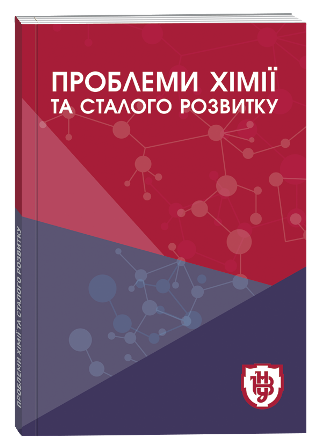THE PHASE EQUILIBRIA OF THE PbS-La(Pr)2S3-Y(Er)2S3 SYSTEMS
DOI:
https://doi.org/10.32782/pcsd-2021-2-7Keywords:
crystalline structure, a unit cell, isothermal section, quasi-binary sectionAbstract
Research of phase equals in quasi-ternary systems – creation of a stage of formation of basic knowledge about materials. Each crystal structure is a new motive for the organization of atoms, which allows us to explain some patterns of formation without creating more complex phases. During the research of the quasi-ternary systems PbS–La(Pr)2S3–Y(Er)2S3 by studying the complex interactions between binary and ternary phases, which are created on the corresponding quasi-binary transfers. Samples for analysis are obtained by direct synthesis from elementary components of high purity. The maximum synthesis temperature was 1323 K. For this temperature, the samples are maintained for 2 hours. Subsequently, annealing was performed at 770 K for better homogenization. After aging, the ampoules are hardened in water at the room temperature. Diffractograms of the samples were obtained on DRON-4-13. According to X-ray phase analysis, the creation of new quaternary phases is not observed in the systems. This motif of phase equilibria is explained by the organization of atoms in binary compounds. In the analysis of binary compounds that create quasi-binary transitions SnS2 - Y(Er)2S3, it was found that the motives of the organization of atoms are not reproduced for the formation of the ternary phase, in contrast to the case of SnS2 - La(Pr)2S3 motifs are combined with the formation of ternary phases La2SnS5 and Pr2SnS5. In fact, the motif State-content of the phase is part of the structure of the La-content and as a result, the parameters of the cells increase slightly. Collectively, during the transitions to the quasi-ternary system, as a result of the above-mentioned description, the motifs of the atoms are not combined and new quaternary compounds are not created. At work, the results of X-ray phase analysis constructed isothermal sections of the quasi-ternary systems PbS – La(Pr)2S3 – Y(Er)2S3 at the temperature 770 K. Between the compounds Y(Er)2S3 – La(Pr)2SnS5 there are quasi-binary equilibria.
References
Kolobov A.V., Tominaga J., Chalcogenides: metastability and phase change phenom-ena. Springer Science & Business Media. 2012. vol. 164.
Fu L., Kane C.L., Mele E.J., Topological insulators in three dimensions, Phys. Rev. Lett. 2007. V.98.
Tritt T.M. Thermal Conductivity: Theory, Properties, and Applications. Springer Science & Business Media. 2005. P. 105-121.
Eggleton B.J., Luther-Davies B., Richardson K. Chalcogenide photonics. Nat. Photon. 2011. V.5. P. 141-148.
Mizuguchi Y., Takano Y. Review of Fe chalcogenides as the simplest Fe-based super-conductor. J. Phys. Soc. Jpn. 2010. V. 79.
Si Q., Yu R., Abrahams E. High-temperature superconductivity in iron pnictides and chalcogenides. Nat. Rev. Mater. 2016. V. 1.
Spaldin N.A. Magnetic Materials: Fundamentals and Applications. Cambridge University Press. 2010. Second edition.
Марчук О.В., Гулай Л.Д. Фазові рівноваги у системах La2X3 – PbX – SiX2 (X – S, Se) за температури 770 K. Наук. вісн. ВНУ, серія “Хімічні науки”. 2012. № 17(242). C. 93-97.
Noda Y. Masumoto K., Ohba S. Temperature Dependence of Atomic Thermal Parameters of Lead Chalcogenides, PbS, PbSe and PbTe. Acta Cryst. 1987. V. 43. P. 1443-1445
Skums V.F., Pink R.L., Allasov M.R. Solid solutions of the PbSe – PbS system at high pressures. Inorg. Materials (USSR). 1991. V. 27. P. 1336-1340
Schleid T., Lissner F. Einkristalle von A-Nd2S3, U-Ho2S3, D-Er2S3 und E-Lu2S3 durch Oxidation reduzierter Chloride der Lanthanide mit Schwefel. Z. Anorg. Allg. Chem. 1992.V. 615. P. 19–26
Schleid T., Lissner F. A-Pr2S3, D-Ho2S3 und E-Yb2S3: Synthese und Einkristalluntersuchungen. Z. Anorg. Allg. Chem. 1968. V. 7. P. 2282–2288
Gulay L.D., Daszkiewicz M., Shemet V.Ya., Olekseyuk I.D. Crystal structure of the R6Pb2Se11 (R = Y, Dy and Ho) compounds. J. Alloys Compd. 2005. V. 403. P. 206-210
Marchuk O.V., Gulay L.D., Shemet V.Ya., Olekseyuk I. D. Investigation of the Pr2Se3 – Cu2Se – PbSe and Pr2Se3 – Ag2Se – PbSe systems. J. Alloys Compd. 2006. V. 416. P. 106-109
Sharma R.C., Lin J.C., Chang Y.A. Metall. Trans. Data Base of Diagrams. Inst, of Chem. Materials Problems. 1999. V. 237. P. 1987
Okamoto H. Pr – S (Praseodymium – Sulfur). J. Phase Equilib. 1991. V. 12, № 5. P. 618-619.
Смітюх О.В., Марчук О.В., Олексеюк І.Д., Гулай Л.Д. Фазові рівноваги в системі PbS – Er2S3 – Pr2S3 за температури 770 К. Матеріали XIV всеукраїнської конференції молодих вчених та студентів з актуальних питань сучасної хімії. Дніпропетровськ: 24-26 травня 2016 р., Маторина К.В. Дніпропетровськ: ЛІРА, 2016. С. 90.
Zintl E., Loosen K. Siliciumdisulfid, ein anorganischer Faserstoff mit Kettenmolekuelen. Z. Phys. Chem, 1935. Vol. 174, pp. 301-311.







